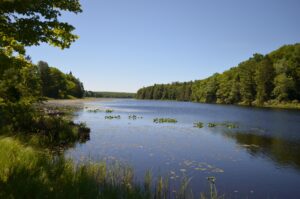Explore Centre County’s History & Culture
Welcome to the Centre County Encyclopedia of History & Culture, an online resource sponsored by the Centre County Historical Society.
Currently, we are featuring articles about Black Moshannon State Park and the Civilian Conservation Corps (CCC). The park, which sits atop the Allegheny Front at an elevation of 1,900 feet, was established in 1937 after CCC workers built a dam, log cabins, picnic pavilions, and trails. The CCC was a government jobs program during the Great Depression that put unemployed men to work across the U.S., including four sites in Centre County.
We welcome your feedback about all the articles in the encyclopedia as well as your suggestions for future encyclopedia articles.
Featured Articles
Black Moshannon State Park is a 3,394-acre park that conserves a unique natural environment surrounding Black Moshannon Lake. The park, was established in 1937 after the Civilian Conservation Corps (CCC) built a dam, log cabins, picnic pavilions, and trails.
Learn More>>The Civilian Conservation Corps was a government jobs program, conceived during the Great Depression, that put thousands of unemployed men to work primarily in state and national parks and forests, including four sites in Centre County.
Learn More>>See What's New
The Bellefonte Academy was a popular private school that educated students from Centre County and across Pennsylvania for more than 125 years. The “School in the Mountains,” as it was known, operated from 1805-1934, except during the War of 1812 and Civil War.
Learn More>>College Heights is a residential neighborhood in State College that was originally developed to provide housing for Penn State faculty, staff, and students. Much of the neighborhood is included in a National Register Historic District.
Learn More>>Fred Lewis Pattee was an author, literary scholar, and English professor at Penn State. He wrote the alma mater and made numerous other contributions to the college. The Pattee Library is named for him.
Learn More>>The Scotia Barrens is a distinct ecozone of about 6,200 acres west of State College protected within State Game Lands #176. The area is a microclimate zone, with temperatures noticeably lower than the adjoining areas, that features plentiful plant and animal life.
Learn More>>


